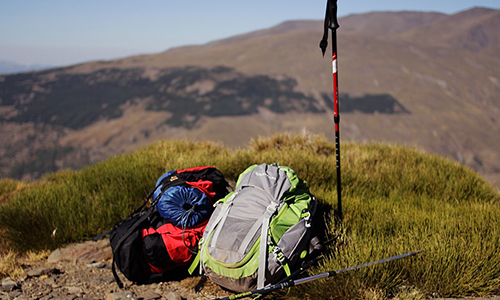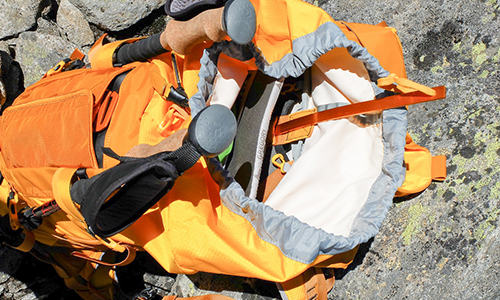A Considerable Difference between an Internal and External Frame Pack
Author

A keen runner, skier and nuts about cycling. Karl lives in Cumbria, where he loves encouraging his two children to follow in his outdoor lifestyle. Whilst out and about keeping active, Karl keeps a diary and shares it with Outdoor Look.
 External frame backpacks have been substantially used by climbers, hikers and campers because of their brilliant design and utility. However, these are getting rarer to spot as sleeker and innovative internal frame bags have moved into the market.
External frame backpacks have been substantially used by climbers, hikers and campers because of their brilliant design and utility. However, these are getting rarer to spot as sleeker and innovative internal frame bags have moved into the market.
External Frame Packs
These are good for lashing on gear that is bulky, making them a preferred choice among hunters and crews. Their visible frame element is their identity. They serve you best when you take them on well-maintained and well-graded trails.
Internal Frame Packs
These are better in terms of their structural flexibility. Much sleeker design is form-fitting, holding the weight closer to the body. This makes them way more stable than the external frame backpacks. You can take them on rugged trails or an off trail path. The slim design makes them less likely to bang into branches or get stuck in a brush or rock face.
Here are five general differences that these frame packs have between each other:
Storage Capacity – Though both are available in same storage capacities of 60 litres, the external frame bags feature exposed frame pieces that can be used to lash heavy and bulky items whereas an Internal frame backpacks feature lash patches that you can use to attach extra gear e.g a sleeping bag.
Weight Distribution and Support – The external frame backpacks transfer the weight to the hips and back in a way that the upright position is maintained while walking. However, this walking position makes you slower, which is a hindrance in case you need to move quickly. In case of the internal frame backpacks, their design makes them stick closer to the body, thus creating more stability and ease of carry the load, even on difficult terrains. Most internal frame backpacks have suspension systems that help transfer the weight to the hip effectively. Their advanced dynamics allow you to easily twist and turn without losing balance.
Organization of Items – External backpacks are typically designed with plenty of side pockets that are really helpful when there is a lot smaller gear which you don’t know where to keep. The main compartment access is also from the top. The internals, however, are available in a variety of options, from ultra-light with few pockets to the deluxe with plenty of pockets; these backpacks have something to offer for every travelling condition. The main compartment access also varies with each type of internal frame backpack. Some have front or a top panel and other have side zipped panels.
Cooling Mechanisms – One of the most necessary comfort features is each backpack have a different set of cooling mechanism. The externals have a large space between the pack bag and the frame which allows the air to flow across the back. For better ventilation, internal backpacks have air channels that help keep your back cool. Also, the suspended mesh panels on the back give breathability to the fabric.
 Cost Effectiveness – It is no more a concern for an average camper, hiker or trekker as both these backpacks can be bought at a bargain price. Though, the internals are getting much more popular because of the comfort and design. In the initial years of internal frame backpacks, the cost was way low in comparison to the externals. But with the advancement in technology and design, these have become the super techy and pricey backpacks. This does not mean that there is no good quality backpack available in the market at an affordable price.
Cost Effectiveness – It is no more a concern for an average camper, hiker or trekker as both these backpacks can be bought at a bargain price. Though, the internals are getting much more popular because of the comfort and design. In the initial years of internal frame backpacks, the cost was way low in comparison to the externals. But with the advancement in technology and design, these have become the super techy and pricey backpacks. This does not mean that there is no good quality backpack available in the market at an affordable price.
Author

A keen runner, skier and nuts about cycling. Karl lives in Cumbria, where he loves encouraging his two children to follow in his outdoor lifestyle. Whilst out and about keeping active, Karl keeps a diary and shares it with Outdoor Look.
Categories
- Sport (28)
- Product Reviews (3)
- Team Outdoor Look (7)
- Mike Wild (2)
- Mike Payton (2)
- Suse Hammond-Pears (3)
- Snowboarding (12)
- Latest Offers (105)
- Shop Talk (1)
- Competitions (7)
- Walking (413)
- Lifestyle Fashion (8)
- Travel (86)
- Kit Guides (176)
- Workwear Clothing (6)
- Safety Workwear (4)
- Health/Fitness (289)
- Skiing (91)
- Great Outdoors (1316)
- Cycling (92)
- January 2025
- December 2024
- November 2024
- October 2024
- September 2024
- August 2024
- July 2024
- June 2024
- May 2024
- April 2024
- March 2024
- February 2024
- January 2024
- December 2023
- November 2023
- October 2023
- September 2023
- August 2023
- July 2023
- June 2023
- May 2023
- April 2023
- March 2023
- February 2023
- January 2023
- December 2022
- November 2022
- October 2022
- September 2022
- August 2022
- July 2022
- June 2022
- May 2022
- April 2022
- March 2022
- February 2022
- January 2022
- December 2021
- November 2021
- October 2021
- September 2021
- August 2021
- July 2021
- June 2021
- May 2021
- April 2021
- March 2021
- February 2021
- January 2021
- December 2020
- November 2020
- October 2020
- September 2020
- August 2020
- July 2020
- June 2020
- May 2020
- April 2020
- March 2020
- February 2020
- January 2020
- December 2019
- November 2019
- October 2019
- September 2019
- August 2019
- July 2019
- June 2019
- May 2019
- April 2019
- March 2019
- February 2019
- January 2019
- December 2018
- November 2018
- October 2018
- September 2018
- August 2018
- July 2018
- June 2018
- May 2018
- April 2018
- March 2018
- February 2018
- January 2018
- December 2017
- November 2017
- October 2017
- September 2017
- August 2017
- July 2017
- June 2017
- May 2017
- April 2017
- March 2017
- February 2017
- January 2017
- December 2016
- November 2016
- October 2016
- September 2016
- August 2016
- July 2016
- June 2016
- May 2016
- April 2016
- March 2016
- February 2016
- January 2016
- December 2015
- November 2015
- October 2015
- September 2015
- August 2015
- July 2015
- June 2015
- May 2015
- April 2015
- March 2015
- February 2015
- January 2015
- December 2014
- November 2014
- October 2014
- September 2014
- August 2014
- July 2014
- June 2014
- May 2014
- April 2014
- March 2014
- February 2014
- January 2014
- December 2013
- November 2013
- October 2013
- September 2013
- August 2013
- July 2013
- June 2013
- May 2013
- April 2013
- March 2013
- February 2013
- January 2013
- December 2012
- November 2012
- October 2012
- September 2012
- August 2012
- July 2012
- June 2012
- May 2012
- April 2012
- March 2012
- February 2012
- January 2012
- December 2011
- November 2011
- October 2011
- September 2011
- August 2011
- May 2010
- April 2010
- March 2010
- February 2010
- January 2010
- November 2009
- October 2009
- September 2009
Submit a Comment